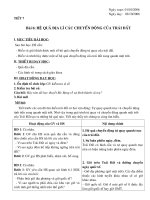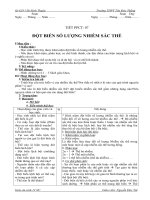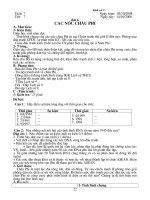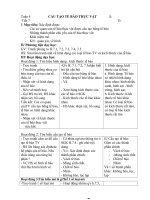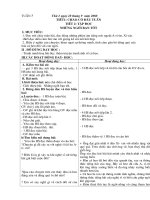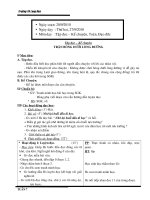Api rp t 7 1995 scan (american petroleum institute)
Bạn đang xem bản rút gọn của tài liệu. Xem và tải ngay bản đầy đủ của tài liệu tại đây (705.93 KB, 15 trang )
A P I RP*T-7
95
0732290 0549353 5T7
Training of Personnel in Rescue
of Persons in Water
API RECOMMENDED PRACTICE T-7
SECOND EDITION, OCTOBER 1995
Amerkan
Petroleum
Institute
--`,,-`-`,,`,,`,`,,`---
Copyright American Petroleum Institute
Provided by IHS under license with API
No reproduction or networking permitted without license from IHS
Not for Resale
~
A P I RP*T-7
75 111 0732270 0 5 4 7 3 5 4 4 3 3
=
Training of Personnel in Rescue
of Persons in Water
--`,,-`-`,,`,,`,`,,`---
Exploration and Production Department
API RECOMMENDED PRACTICE T-7
SECOND EDITION, OCTOBER 1995
American
Petroleum
Institute
Copyright American Petroleum Institute
Provided by IHS under license with API
No reproduction or networking permitted without license from IHS
Not for Resale
~
A P I RP*T-7
75
0 7 3 2 2 9 0 0549355 37T
SPECIAL NOTES
1. API PUBLICATIONS NECESSARILY ADDRESS PROBLEMS OF A GENERAL
NATURE. WITH RESPECT TO PARTICULAR CIRCUMSTANCES, LOCAL, STATE,
AND FEDERAL LAWS AND REGULATIONS SHOULD BE REVIEWED.
2. MI IS NOT UNDERTAKING TO MEET THE DUTIES OF EMPLOYERS, MANUFACTURERS, OR SUPPLIERS TO WARN AND PROPERLY TRAIN AND EQUIP
THEIR EMPLOYEES, AND OTHERS EXPOSED, CONCERNING HEALTH AND
SAFETY RISKS AND PRECAUTIONS, NOR UNDERTAKING THEIR OBLIGATIONS
UNDER LOCAL, STATE, OR FEDERAL LAWS.
3. INFORMATION CONCERNING SAFETY AND HEALTH RISKS AND PROPER
PRECAUTIONS WITH RESPECT TO PARTICULAR MATERIALS AND CONDITIONS SHOULD BE OBTAINED FROM THE EMPLOYER, THE MANUFACTURER
OR SUPPLIER OF THAT MATERIAL, OR THE MATERIAL SAFETY DATA SHEET.
4. NOTHING CONTAINED IN ANY API PUBLICATION IS TO BE CONSTRUED AS
GRANTING ANY RIGHT, BY IMPLICATION OR OTHERWISE, FOR THE MANUFACTURE, SALE, OR USE OF ANY METHOD, APPARATUS, OR PRODUCT COVERED BY LETTERS PATENT. NEITHER SHOULD ANYTHING CONTAINED IN
THE PUBLICATION BE CONSTRUED AS INSURING ANYONE AGAINST LIABILITY FOR INFRINGEMENT OF LETTERS PATENT.
5. GENERALLY, API STANDARDS ARE REVIEWED AND REVISED, REAFFIRMED, OR WITHDRAWN AT LEAST EVERY FIVE YEARS. SOMETIMES A ONETIME EXTENSION OF UP TO TWO YEARS WILL BE ADDED TO THIS REVIEW
CYCLE. THIS PUBLICATION WILL NO LONGER BE IN EFFECT FIVE YEARS AFTER ITS PUBLICATION DATE AS AN OPERATIVE API STANDARD OR, WHERE
AN EXTENSION HAS BEEN GRANTED, UPON REPUBLICATION. STATUS OF THE
PUBLICATION CAN BE ASCERTAINED FROM THE API AUTHORING DEPARTMENT [TELEPHONE (202) 682-8000]. A CATALOG OF API PUBLICATIONS AND
MATERIALS IS PUBLISHED ANNUALLY AND UPDATED QUARTERLY BY API,
1220 L STREET, N.W., WASHINGTON, D.C. 20005.
All rights reserved. No part of this work may be reproduced, stored in a retrieval system,
or transmitted by any means, electronic, mechanical, photocopying, recording, or herwise, without prior written permission from the publisher. Contact API Publications
Manager, 1220 L Street, N.W., Washington, D.C. 20005.
--`,,-`-`,,`,,`,`,,`---
Copyright O 1995 American Petroleum Institute
Copyright American Petroleum Institute
Provided by IHS under license with API
No reproduction or networking permitted without license from IHS
Not for Resale
A P I RPbT-7
95 BI 0732290 0 5 4 9 3 5 6 2 0 6
=
CONTENTS
Page
O INTRODUCTION ...................................................................................................
O.1 Notification .......................................................................................................
0.2 Communications ...............................................................................................
0.3 Locate ...............................................................................................................
0.4 Survival .............................................................................................................
0.5 Recovery ...........................................................................................................
0.6 Post-Recovery First Aid ....................................................................................
.....................................................................................................................
REFERENCES ........................................................................................................
RECORDS ...............................................................................................................
GENERAL INFORMATION ..................................................................................
RESCUE DEVICES-DESCRIPTION AND USE ................................................
5.1 Platform and MODU ........................................................................................
5.2 Helicopters ........................................................................................................
5.3 Rescuing Vessels ...............................................................................................
5.4 Survival Craft ....................................................................................................
5.5 Rescue Boats .....................................................................................................
TRAINING GUIDELINES .....................................................................................
6.1 General Training Information ...........................................................................
6.2 Platform and MODU ........................................................................................
6.3 Helicopters ........................................................................................................
6.4 Rescuing Vessels ...............................................................................................
6.5 Inflatable Rafts ..................................................................................................
6.6 Survival Craft ....................................................................................................
6.7 Rescue Boats .....................................................................................................
1
1
1
1
1
1
1
1 SCOPE
1
2
3
2
4
5
6
...
111
--`,,-`-`,,`,,`,`,,`---
Copyright American Petroleum Institute
Provided by IHS under license with API
No reproduction or networking permitted without license from IHS
Not for Resale
2
2
2
2
3
3
4
4
4
4
5
5
6
6
7
8
A P I RP*T-7
95 E 0 7 3 2 2 9 0 0549157 1 4 2 E
FOREWORD
This Recommended Practice (Rp)was developed under the jurisdiction of the American Petroleum Institute’s (API’s) former Committee on Offshore Safety and Anti-Pollution
Training and Motivation (OSAFTM), and its parent, API Production Department Executive Committee on Training and Development. It has been prepared with the overall advisory guidance of the API, the Offshore Operators Committee (OOC), the Western States
Petroleum Association (WSPA), the International Association of Drilling Contractors
(LAX)the
, Helicopter Safety Advisory Conference (HSAC), and the Offshore Marine Service Association (OMSA).
Criteria presented in this Recommended Practice should be used as a guide for rescue
training programs by companies engaged in offshore operations. Such programs shall be
consistent with applicable authorities and regulations. Training should include techniques
for assistance in the rescue of persons in the water at the job site or during transportation
to/from the work location, and be consistent with safe practice.
This publication includes usage of the verbs shall and should, whichever is the more
applicable to the function. Both shall and should are positive statements and should be
treated as such. For the purpose of this publication the following definitions apply:
Shall: Indicates that the function has universal applicability to the specific activity.
Should: Indicates that: (1) the function may have an alternative practice that is equivalent and could be applied; or (2) the practice may not be practical or necessary under certain conditions; or (3) the practice may not be applicable to a specific facility or
configuration.
API publications may be used by anyone desiring to do so. Every effort has been made
by the Institute to assure the accuracy and reliability of the data contained in them; howevër,
the Institute makes no representation, warranty, or guarantee in connection with this publication and hereby expressly disclaims any liability or responsibility for loss or damage
resulting from its use or for the violation of any federal, state, or municipal regulation with
which this publication may conflict.
Suggested revisions are invited and should be submitted to the director of the Exploration and Production Department, American Petroleum Institute, 1220 L Street, N.W.,
Washington, D.C. 20005.
iv
--`,,-`-`,,`,,`,`,,`---
Copyright American Petroleum Institute
Provided by IHS under license with API
No reproduction or networking permitted without license from IHS
Not for Resale
~~
A P I RP*T-7
75 W 0732290 05Y7158 Oô9
Training of Personnel in Rescue of Persons in Water
O Introduction
ment and materials that will aid in readily locating them and
augment their ability to survive until they are rescued.
On occasion, personnel may fall overboard or due to
emergencies may be forced to abandon their unit and enter
the sea. Various devices, procedures, and rescue knowledge
may be used to increase their chances for rescue and survival. Many factors impact the ability to survive and be rescued. A rescue of any type may be broken down into the
following elements or phases.
0.5 RECOVERY
Perhaps the most difficult phase of a rescue is the recovery of persons from the water or survival device.A quick response is necessary and training in the use of available
rescue equipment is important. The longer a person is in the
water, the less likely he or she is to survive. In the event of a
rescue emergency, personnel must have a good knowledge
of devices available as well as the ability to properly utilize
them in order to keep response time to a minimum.
0.1 NOTIFICATION
Persons with the means to perform the rescue must be
made aware that persons are in distress. This includes “passing the word” to the person in charge when seeing a man
overboard, or transmitting a mayday on a radio when a unit
is in distress. Vessels in the area, the United States Coast
Guard (USCG), nearby facilities, and helicopter personnel
should be alerted if assistance is needed. It is always appropriate to contact the USCG in a distress situation. Even if
the nearest USCG facility is not nearby, it may have an aircraft or vessel transiting the area.
0.6 POST-RECOVERY FIRST AID
Certain first-aid actions performed within minutes of recovery may greatly enhance an individual’s chance of survival. The effects of exposure to the elements should always
be considered when recovering a person from the water.
1
COMMUNICATIONS
One of the most important elements in every successful
rescue effort is communication between participants:
0.2
This Recommended Practice applies to personnel who
work offshore and represents an industry guide for training
personnel in techniques for rescuing persons from the water
and from survival devices in the water. It broadly identifies
rescue devices, describes their operations, and presents recommendations for training personnel in their use as either a
rescuer or a person being rescued. These training recommendations are designed to develop personnel rescue proficiency while minimizing an individual’s exposure to injury
or loss of life.
The training may be either hands-on or classroom based.
Some suggested approaches are included. The Recommended Practice encourages the employer, when deciding
the conditions under which training and drills are to be carried out, to fully consider all safety aspects of the training.
Training should be as broad as is practical. It should emphasize those devices likely to be available to the employee at
his or her assigned location.
These guidelines are general and may or may not be sufficient for all circumstances or operations. The employer
should not limit or reduce the company’s present program as
a result of the publication of these guidelines.
a. Between the person in charge of an offshoreunit and aircraft or vessel resources.
b. Between units involved in any search for survivors.
c. Between the occupants of a survival craft, and rescue
vessel or aircraft.
0.3
LOCATE
Locating persons in distress may be difficult. Emergency
Positioning Indicator Radio Beacon (EPIRB), reflective
tape, international orange lifesaving devices, whistles, ring
buoys, smoke canisters, flares, and water lights, as well as
other devices, can assist in this effort.
0.4
Scope
SURVIVAL
Making the best use of the materials at hand to prevent
drowning and minimize the possible effects of exposure is
important. Persons in the water or aboard survival devices
may be assisted by providing them with additional equip1
--`,,-`-`,,`,,`,`,,`---
Copyright American Petroleum Institute
Provided by IHS under license with API
No reproduction or networking permitted without license from IHS
Not for Resale
~~
A P I RP*T-7
95
m
0 7 3 2 2 9 0 0549359 T35
m
API RECOMMENDED
PRACTICE
T-7
2
2 References
5.1.3
The following recommended practices are cited herein:
API
T-1
T-4
Orientation Programs f o r Personnel Going
Offshorefor the First Time
Training of Offshore Personnel in Nonoperating
Emergencies
3 Records
--`,,-`-`,,`,,`,`,,`---
Employers shall maintain a record at a central location
documenting the training each employee has received in accordance with the provisions of this Recommended Practice.
Documentation of the training should be made available to
those employees whose work location varies.
4 General Information
Employers should ensure their employees have received
instructions in accordance with API Recommended Practice
T-1: Orientation Programs for Personnel Going Offshorefor
the First Time; and with API T-4: Training of Wshore Personnel in Nonoperating Emergencies.
5 Rescue Devices-Description
5.1
and Use
PLATFORM AND MODU
Devices on fixed platforms, Mobile Offshore Drilling
Units (MODUS) and vessels that may be used for rescue of
persons in the water include but are not limited to:
5.1.1
Ring Life Buoy
Also referred to as throw rings or life rings, these devices
generally are constructed of unicellular plastic in the shape
of a ring with a grab line. On offshore facilities, they are intended primarily to be thrown to a man overboard to provide
buoyancy and stability to aid in keeping persons afloat in the
water. The throw must be prompt and accurate for this rescue technique to be successful, particularly if there are unfavorable sea currents or wind conditions.
5.1.2
Safety Litter
This type of device is intended primarily to be used to
move and transport an injured person. It can also be used as
a rescue device if lowered to the water by means of a crane
or hoist. Specifically designed sling systems are available for
use with safety litters. Safety litters equipped with a buoyant
ring are particularly effective for rescue of injured persons
from water.
Copyright American Petroleum Institute
Provided by IHS under license with API
No reproduction or networking permitted without license from IHS
Personnel Basket
This device normally is used for moving personnel to and
from vessels using the platform crane. However, it can be
useful as a rescue device if positioned on the water where a
man overboard could swim to it, or to lower someone to assist a man overboard.
5.1.4
Type I Personal Flotation Device (PFD)
These devices, designed to be worn like a jacket, support
the wearer in the water in an upright or slightly backward position and provide support to the head so that the face of an
unconscious or exhausted person is held above the water.
They are intended to be worn during an emergency evacuation situation or when working over water. However, they
could be a useful rescue device if thrown to someone overboard in a case where a ring life buoy is not available, or if
worn by someone going into the water to rescue a man overboard. They are equipped with reflective tape and lights to
aid in locating personnel in the water.
5.1.5
Type V Personal Flotation Device
(Work Vest)
Work vests are items of safety apparel worn by persons
when working near or over the water, except that they shall
not be used in lieu of the approved Type I PFD’s that are to
be worn during drills and emergencies. Work vests could be
thrown to a man overboard if ring life buoys are not readily
available.
5.1.6 Exposurefimmersion Suits
These suits are normally provided during operations north
of 32 degrees north latitude in the Atlantic Ocean and 35 degrees north latitude in the Pacific Ocean. Suits are available
with and without buoyancy and are intended primarily as
protection from exposure to the elements. Suits with buoyancy could be used by both rescuers and persons being rescued.
5.1.7 Life Floats
Life floats are buoyant devices that require no preparation
for use. They are designed to support a specified number of
persons in the water. They are designed with a continuous
body in the shape of either an ellipse or a rectangle with a
circular, elliptical, or rectangular body cross section. They
typically are equipped with a platform designed so that persons supported inside are partially immersed, and generally
are equipped with paddles.
Inflatable Rafts
Two types of canister-packed, inflatable raft installations
are used offshore: davit-launched inflatables and hydrostaticaily released inflatables. The launching procedure is the
major difference; otherwise they are manned and operated
5.1.8
Not for Resale
API R P J T - 7
95
0732270 0549160 737 M
TRAINING
OF PERSONNEL
IN RESCUEOF PERSONS
IN WATER
5.2 HELICOPTERS
The helicopter has the capability to travel at high speed
to an emergency site and assist people in the water by delivering flotation devices or by rescuing them directly from the
water. Some helicopter rescue devices and techniques, and
limiting factors that may influence their selection, are listed
below:
5.2.1
Hoist (USCG)
5.2.1.1 An electrically or hydraulically operated hoist is
available on USCG helicopters. It lowers a hoisting device
(sling, harness, seat, or basket) from a hovering helicopter to
lift personnel from the surface into the helicopter.
5.2.1.2 The pilot hovers the helicopter in a position that
allows the hoist operator to lower the hoisting device and
raise the person being rescued to the helicopter and then inside. A rescuer aboard the helicopter may enter the water to
assist incapacitated personnel.
5.2.1.3 A person being rescued may be required to put on
or enter the hoisting device unassisted while the helicopter
hovers overhead. Uninjured personnel in the water should
assist any incapacitated personnel into the hoisting device.
5.2.1.4 It is always appropriate to contact the USCG;
however, depending on the distance of the nearest available
USCG helicopter from the rescue site, response time may be
a limiting factor when considering this technique. Hoisting
has been accomplished in winds exceeding 50 knots and seas
exceeding 30 feet.
5.2.2 Helicopter External Delivery of Life-Float
5.2.2.1 A life-float can be picked up at an offshore platform, carried beneath the helicopter on its external cargo
hook, and released near personnel in the water to provide
them with extra flotation. Once the life-float has been released, a helicopter that is not equipped to pick up survivors
may be used for observation.
5.2.2.2 Minimum crew would consist of one pilot. Platform personnel may be called upon to assist with the initial
hookup of the life-float.
5.2.2.3 This is considered a short-distanceresponse since
the maximum cruise speed with this external load will be
50-60 miles per hour.
5.2.2.4 Wind and weather conditions are limiting factors
when considering this technique.
Copyright American Petroleum Institute
Provided by IHS under license with API
No reproduction or networking permitted without license from IHS
Not for Resale
5.2.3
Inflatable Life Raft, Life Ring, or PFD Drop
5.2.3.1 An inflatable life raft, inflatable life ring, solid life
ring, or PFD can be transported internally by the helicopter
and dropped to persons in the water. The life raft is dropped
from a hover by a person who holds a tether line attached to
the inflation lanyard. When the raft lands in the water, the
tether line is jerked to inflate the raft. The line is then released or can be used to tow the raft within reach of the survivors prior to release. The inflatable life ring is a
softball-sized package that inflates on water contact and
would normally be thrown without a tether line to survivors.
Some versions incorporate a hoisting ring. The standard noninflatable life ring can be thrown to survivors either with or
without a tether line.
5.2.3.2 Minimum crew consists of one pilot and a person
who will deploy the life raft or life ring. A coordination
briefing is required to minimize the risk of injury to the rescuer or the person being rescued, as well as to ensure that
any ropes stay clear of helicopter rotors and landing gear.
--`,,-`-`,,`,,`,`,,`---
the same. There may be instances when an inflatable raft can
be used as a rescue device, as in man overboard situations
where launching rescue equipment or calling rescue sources
would not be fast enough. However, it must be kept in mind
that an inflatable raft has limited maneuverability and must
be recovered.
3
5.2.3.3 Persons being rescued need only board the raft or
don the life ring.
5.2.3.4 The helicopter range and cruise speed are not affected and a larger radius of response is feasible using this
type of rescue equipment.
5.2.3.5 Wind and weather conditions and door configuration are limiting factors when considering this technique.
Since the door must be open to drop the raft, hinged doors
must be removed or held open against the wind in a hover.
5.2.4 Miscellaneous
5.2.4.1 Always consider whether the survivor may be
safer where he or she is before deciding to attempt a rescue
with improvised equipment.
5.2.4.2 Various items found on the platform can be suspended from the helicopter to provide a means for lifting a
person from the water. The platform personnel basket or
other nets not incorporating flotation should be considered
for use as a helicopter rescue device only as a last resort because of the potential of personnel being entangled in the device.
5.2.4.3 Any rescue in which a person is suspended beneath the helicopter, and not hoisted into it, must necessarily
be conducted at the lowest altitude, slowest speed, and shortest distance possible.
5.3 RESCUING VESSELS
A master or individual in charge of a vessel must render
assistance to any individual found at sea in danger of being
lost, so far as the master or individual in charge can do so
without serious danger to the vessel or other individuals on
board. Any vessel in the vicinity of an offshore work site
A P I RP*T-7
95
API RECOMMENDED
PRACTICE
T-7
4
--`,,-`-`,,`,,`,`,,`---
must respond to any call for assistance in an emergency, The
vessel will proceed to the site to assist in the recovery of a
man overboard from the water. The ability of a vessel to provide any real assistance in an emergency will vary significantly according to the vessel size, type, equipment, crew
size, cargo, and weather conditions-any or all of which
may be limiting factors in considering vessel rescue techniques.
The alerted vessel standing by the distressed unit may be
called upon to remove persons from the water. Ancillary devices may be required to assist persons from the water in order to improve the efficiency of the operation, to augment
small crew size, or because of the freeboard of the vessel.
Examples of the devices that may be rigged alongside to assist boarding include boarding ladders, life-floats, skiffs,
rafts, rescue platform, fish davits with knotted lines, or a
safety litter with flotation collars. Boarding also may be assisted by means of a portable rescue platform, scramble nets,
or other devices lowered over the side.
5.4
SURVIVAL CRAFT
Survival craft, for purposes of this Recommended Practice, include motorized survival capsules and motorized covered and uncovered lifeboats. While these craft normally are
used as escape vessels, they also can be utilized to rescue
persons in the water.
5.5
0732290 0549LbL b73
RESCUE BOATS
Rescue boats are designed to provide quick response in
the rescue and retrieval of personnel who are in the water. A
rescue boat generally is launched from a larger vessel and is
manned by members of the crew. A rescue boat may be of
rigid or inflatable construction, or a combination of both.
The low profile and rounded shape of the sides of an inflatable or rigid inflatable rescue boat make it relatively easy for
a person to board or to be assisted aboard. The boat may be
equipped with an outboard engine or an inboard engine, or
not equipped with an engine at all. In the latter case, the boat
may be rowed to reach the person or persons, or it may be
towed behind or rigged alongside the larger vessel and used
as a boarding aid.
6 Training Guidelines
6.1 GENERAL TRAINING INFORMATION
Training in rescue of personnel in the water should encompass general considerations as well as training specific
to rescue devices for the rescuer and the person being rescued. The primary objective is for every affected employee
to be familiar with the emergency rescue plans, location of
equipment to be used in a rescue, and the best techniques for
Copyright American Petroleum Institute
Provided by IHS under license with API
No reproduction or networking permitted without license from IHS
its use. The need to respond or deploy resources promptly
should be stressed. Sections 6.2 through 6.7 provide guidelines for initial and ongoing training on respective equipment. Initial training should be conducted as soon as is
practical. Ongoing training should be conducted on a periodic basis. Additional considerations that should be included
in rescue training include:
6.1.1 Communications
6.1.1.1 All necessary sources of aid should be alerted as
soon as possible to a rescue emergency to lessen response
time. This includes passing the word in the event of a man
overboard.
6.1.1.2 Sources of aid (i.e., vessels and aircraft) en route
should be advised of the type of emergency and conditions at
the scene with emphasis on those items that affect survival
time. Such information should include:
a. Length of time and number of persons in the water.
b. Environmental conditions and forecasts including sea and
air.
c. Crude oil, chemicals, fuel, or debris in water.
d. Conditions on the unit that may limit evacuation methodology.
6.1.1.3 Coordination of available aid should be established and continuous until recovery is complete.
6.1.2
Decision Process
6.1.2.1 Persons coordinating the rescue may need to evaluate the capability of available aid to determine the best rescue procedure.
6.1.2.2 The order of rescue may need to be prioritized according to the physical condition of a person being rescued
or other conditions.
6.1.2.3 Persons in the water should be removed safely
from the water as soon as possible. Judgment capability of a
person being rescued may be affected by:
a.
b.
c.
d.
e.
Injuries.
Exposure to the elements.
Extreme personal discomfort.
Lack of training.
Hysteria.
6.1.2.4 immediate transfer from a lifeboat, inflatable life
raft, or other shelter of relative safety to the rescue vessel
may not be in the best interest of afflicted personnel. The
transfer may present more risk than standing by until conditions improve.
Are the occupants of the craft in any immediate danger?
Where there is more than one person to be rescued, the decision to rescue must be considered according to need and risk
Not for Resale
95
0732290 0549162 50T
TRAINING
OF PERSONNEL
I N RESCUEOF PERSONS
IN WATER
a. Is there a “person in charge” of the craft?
b. Does he/she appear to know what they are doing?
c. Is there panic on board the craft?
d. Can the craft continue to navigate in the existing or forecasted weather conditions?
e. How many persons are injured?
f. What is the seriousness of their injuries?
g. How long until daylight/darkness?
h. Can the craft be taken safely in tow under the existing
weather conditions?
6.2 PLATFORM AND MODU
6.2.1
InitialTraining
The objective should be to integrate basic rescue training
with other safety and orientation training. The training
should include but not be limited to the following:
a. The location of equipment that could be used in the event
of a man overboard situation and a description of its function and operation.
b. How employees should respond if they see a man overboard in the water, and what employees should expect and
do if they were to fall overboard.
c. Ways to assist in one’s own rescue.
6.2.2
Ongoing Training
Periodic training shall occur as a normal part of safety
programs or emergency drills. The objective should be to refresh personnel competence in rescue techniques and equipment, and to improve and maintain readiness to respond
promptly and effectively in the event of a man overboard situation. Also, the training should be conducted in a manner
that would provide opportunity for personnel to resolve any
concerns or questions on the proper techniques. Training
should cover the following topics:
a. The location of devices that could be used for rescue and
their operation.
b. The best techniques for using rescue devices.
c. Inspection and maintenance of rescue equipment.
d. The effects of wind and sea currents on rescue operations.
e. Procedures to use if someone is overboard and what to
expect if one falls overboard.
f. Ways to assist in one’s own rescue.
g. Throwing ring life buoys or other flotation devices to a
person overboard.
h. Connecting a rope and lifesaving harness to a person in
preparation for entering the water to accomplish a rescue.
i. The use of a crane with a personnel basket or a safety litter for rescue operations.
j. How to climb a rope ladder.
k. First aid treatment for persons who have been rescued-shock, hypothermia, etc.
Copyright American Petroleum Institute
Provided by IHS under license with API
No reproduction or networking permitted without license from IHS
Not for Resale
6.2.3
5
Training Location and Drills
Training should be conducted on the fixed platform or
MODU and could include lectures during safety meetings,
films, slide presentations, or video tapes. Approximately
once per year, if feasible, hands-on rescue drills should be
conducted on the fixed platform or MODU under the direction of the person in charge. These drills should include but
not be limited to:
a. Throwing ring life buoys or other flotation devices using
a floating object as a target.
b. Climbing rope ladders if the facility is so equipped.
c. Using a crane to lower a personnel basket andor safety
litter near an object in the water to simulate the rescue of a
person overboard.
d. Deploying a life-float and maneuvering it to the vicinity
of the floating target.
e. Using a survival craft or lifeboat as a rescue vessel to recover a floating object in a simulated rescue.
f. Directing a field utility vessel or standby vessel to simulate a rescue of a floating object.
6.3
6.3.1
--`,,-`-`,,`,,`,`,,`---
API R P * T - 7
HELICOPTERS
initialTraining
Persons being rescued should have knowledge of helicopter rescue methods available, including how to put on
andor board those devices used in helicopter rescue. Procedures for using those devices should be demonstrated to
and/or practiced by personnel working in the offshore environment. It may not be feasible to use a helicopter as part of
a large-scale indochination or training program. To train personnel in these rescue methods, various media or audio-visual aids may be used.
6.3.2 Ongoing Training
The following may be used to further train offshore workers in helicopter rescue operations:
a. Audio-visual aids.
b. Demonstration of and hands-on familiarization with helicopter rescue devices.
c. Observation of rescue exercises conducted by the Coast
Guard or commercial helicopter operators.
d. Classroom or field exercises in preparing injured personnel for rescue.
e. Pool exercises simulating helicopter rescue methods.
6.3.3 Helicopter Crew Training
Pilots should be thoroughly briefed on deployment of the
various types of rescue equipment available, but in most
cases repetitious training is not considered necessary. Complex equipment or procedures may require not only initial
training but also recurrent training to maintain proficiency.
A P I RP*T-7
95
API RECOMMENDEO
PRACTICE
T-7
6
Training methods and techniques for helicopter-assisted
rescues will be subject to Federal Aviation Administration
(FAA) rules and approval. Training programs for flight crews
shall be established by the helicopter operator, approved by
the FAA, and incorporated into the helicopter operator’s
training manuals. The “Person in Charge” will be the helicopter pilot.
6.4
6.4.1
0732290 0 5 4 9 3 6 3 4 4 6
d. Methods for transporting the towline to the survival craft.
e. Towline attachment points for survival craft.
f. Proper towing of survival craft.
6.5 INFLATABLE RAFTS
6.5.1
RESCUING VESSELS
Persons Being Rescued
Personnel working in the offshore environment should receive initial and ongoing training on vessel rescue methods
available, including how to put on and/or board those devices
used in vessel rescue, similar to the training described in
6.3.1 and 6.3.2 for helicopter rescue.
6.4.2 Vessel Crew Training
The training vessel crew is subject to maritime law and
Coast Guard regulation; however, crewmen of all vessels
should be instructed through required reading or otherwise
informed in the following:
a. Donning a personal flotation device.
b. Boarding survivaihescue craft from the water.
c. Effects of immersion in water and hypothermia.
d. Effects of sun, wind, and sea upon ability to survive.
e. Recovering and caring for survivors.
f. Location and use of lifesaving equipment on board the
vessel.
Crewmen should also receive practical instruction during
onboard drills or elsewhere in the following:
a. Assisting persons from the water into survivaVrescue
Craft.
b. Operation of survival/rescue craft equipment.
c. Streaming a sea anchor.
6.4.3 Approaching Survival Craft and
Attaching Towline
The alerted vessel may also be called upon to stand by or
to rig a tether or towline to a life raft, lifeboat, or survival
craft. It may be necessary to stand by until the weather
abates so that the occupants can safely evacuate or be towed
to a harbor of safe refuge. To avoid tipping the craft, the towline should be connected near the water line. Cautionary
note: The towline probably will be attached by the occupants
of the craft being towed. The craft should be towed at a
SLOW speed.
Instructions on safe approach should include:
a. Proper approach by the vessel for rescue of a survival
capsule, life raft, lifeboat, or persons in the water.
b. Effect of wind and sea conditions on the rescue vessel.
c. Effect of wind and sea conditions on the survival craft or
persons in the water.
Initial Training-Location
Method of Deployment
Training should be given on the specific types, operation,
and maintenance of inflatables likely to be found at the location where the new employee will be working, as well as
the types of equipment likely to be found on the boats and
helicopters that service the area. This training should be part
of a new employee’s orientation.
In their training, the employees should be given instruction on how the inflatable raft may be used in rescuing people from the water. They should also be given instruction on
how to deploy an inflatable raft from:
a.
b.
c.
d.
Platforms.
MODUS.
Helicopters.
Boats.
6.5.2
Ongoing Training-Rescue
Methods
Training in how to be rescued from an inflatable raft
should include rescue by the four possible methods as follows:
a.
b.
c.
d.
Rescue by vessel.
Rescue by seaplane.
Rescue by helicopter.
Rescue by survival craft.
Caution is advised concerning the inflation of a raft onboard a rig or platform for training purposes due to the possibility of damaging the raft during inflation and subsequent
repacking into its protective canister. USCG raft approval requirements and the manufacturer’s operations procedures
and instructions should be used to develop specific training
programs involving use of rafts. Note: Repacking a raft on
scene will void required USCG approval. The USCG approval process requires servicing by an approved service facility and has no provision domestically for servicing and
repacking on scene.
The following items should be included when planning
and conducting training for rescue from inflatable rafts:
a. Stay near other rafts if possible.
b. Use all means to attract attention.
c. Signal of rescue units.
d. Plan activities to effect rescue.
e. The need for and organization of discipline, and duties of
the person in charge.
--`,,-`-`,,`,,`,`,,`---
Copyright American Petroleum Institute
Provided by IHS under license with API
No reproduction or networking permitted without license from IHS
and
Not for Resale
A P I RP*T-7
75
= 0732270 0547164 3 8 2
TRAINING
OF PERSONNEL IN RESCUEOF PERSONS IN WATER
6.5.2.1 Rescue by SurfaceVessel
Training in how to be rescued by a surface vessel should
cover, but not be limited to, the following:
a. Prevent fouling of lines or sea anchor with the approaching vessel.
b. Receive and attach a towline. Prepare to be towed:
Proper line to use.
Proper point of attachment to raft.
Need for minimum movement of personnel in raft.
Need to keep towline under observation.
Need to establish basic signaling system with towing
vessel.
Assignment of duties by person in charge of raft.
6.5.2.2
Rescue by Seaplane
Training in how to be rescued by a seaplane should cover,
but not be limited to, the following:
a. Haul in all lines and sea anchors.
b. Paddle toward the aircraft when pilot signals.
c. Watch for propellers.
6.5.2.3
Rescue by Helicopter
Training in how to be rescued by a helicopter should
cover, but not be limited to, the following:
a.
b.
c.
d.
Pilot is in charge of operations.
Raft occupants should indicate wind direction.
Lower radio aerials if erected.
Stay low and keep raft balanced in rotor wash downdraft.
e. Enter the water as lifting device is lowered because raft
will be blown about by the downdraft of helicopter.
f. Rescue with a scoop net or similar device.
g. Rescue with a pickup strap or underarm harness.
h. Rescue by a harnessed crew member if rescuees are helpless.
i. Properly attach lifting device.
j. Keep lift line free and clear.
k. Detach lifting device from lift line while strapping in the
injured.
1. To prevent capsizing, keep raft balanced when personnel
enter the water for rescue or are lifted out of the inflatable
raft.
6.6
6.6.1
SURVIVAL CRAFT
initialTraining
All personnel working on offshore facilities that utilize
motorized survival craft should receive training in the following areas as soon as is practical after their initial arrival:
a. The craft to which they are assigned, their duties as part
of that crew, and the boarding and launching procedures.
b. Survival craft discipline; the person in charge and the
--`,,-`-`,,`,,`,`,,`---
Copyright American Petroleum Institute
Provided by IHS under license with API
No reproduction or networking permitted without license from IHS
Not for Resale
7
chain of command; the use of seatbelts, lifejackets, or immersion suits; prevention of panic.
c. The capabilities and characteristics of their craft in different sea states and conditions, including roll-over and selfrighting ability, stability, and watertight integrity.
d. Familiarization with the mechanical systems that launch,
propel, and protect the craft from fire.
6.6.2 Ongoing Training for Personnel
Being Rescued
Training in how to be rescued from survival craft should
include the following topics:
a. Dangers and risks associated with recovery of personnel
from the craft, especially during adverse conditions.
b. Techniques for recovery of personnel from craft by a
fixed platform or MODU.
c. Techniques for recovery of personnel from the craft by a
Vessel.
d. Techniques for retrieval of the entire survival craft by a
fixed platform or MODU.
e. Techniques and limitations of survival craft pickup by a
vessel equipped with a hoisting apparatus.
f. Techniques and procedures for attaching a towline and
taking the survival craft in tow.
g. Considerations affecting how the occupants of the survival crafỵ are to be rescued. Some of these considerations
are:
The key point in a rescue at sea is that it must be properly planned and timed.
If there are no serious injuries aboard the survival
craft, retrieval or rescue may be delayed until seas are
calm, staying nearby the area where the craft was
launched into the water.
If injuries are involved, their nature and life-threatening potential should be evaluated carefully by the person
in charge before a rescue attempt is made.
h. Techniques for rescue of occupants from the craft during
various situations to be considered are:
Structural damage of the survival craft.
Injury to the occupants.
Debris or petroleum products in the water.
Fire on the water.
i. Techniques to safely maneuver the survival craft alongside the rescue vessel.
j . Techniquesto safely transfer people from a survival craft
to a larger vessel. The training should be as realistic as practical and should be repeated frequently enough to allow
those involved to become familiar with the task.
k. The stability characteristics of the survival craft that that
person may be required to utilize in an emergency. This
training should include instructions or information as to the
righting characteristics of the craft and what to do if the vessel capsizes.
~
API RP*T-7
a
~
95
0732290 0.549365 219
API RECOMMENDED
PRACTICE
T-7
a. Planning, launching, and coordinating the search and rescue.
b. Maintaining communications with spotters on other craft
or facilities.
c. Proper approach to a person in the water; dangers of injury from contact with the boat propeller.
d. The effects that weather conditions and the physical condition of the person in the water will have on rescue techniques.
e. Techniques for getting persons from the water into the
craft. conscious and unconscious.
6.6.4
Ongoing Training for Survival Craft
Persons in Charge
The training of persons in charge shall utilize survival
craft of the same type as will be utilized in an actual offshore
emergency, and should include:
a. Hands-on experience training in maneuvering the survival
craft, and in retrieval of the survival craft by both a fixed
platform and a rescue vessel. These drills may occur as a
portion of any regularly scheduled launch and recovery drill.
b. Procedures for towing of survival craft by another vessel.
c. Hands-on practice of procedures for transfemng personnel from a survival craft to a rescue vessel.
d. Hands-on training in man overboard recovery consisting
Of:
Control operation of craft.
Stability exercise.
Rescue training, including retrieval of an uninjured
and an injured victim.
e. Training in evaluation of the weather and sea states in
making the decision of which type of rescue would be best.
Specifically, the following points shall be thoroughly discussed in this training:
The possibility that, especially in inclement weather,
transferring personnel from the survival craft to a rescue
vessel could put them at ,pater risk.
The hazards involved in transfemng personnel from
the survival craft to a rescue vessel include the necessity
to open the survival craft hatch, which may expose the
otherwise seaworthy craft to swamping.
Copyright American Petroleum Institute
Provided by IHS under license with API
No reproduction or networking permitted without license from IHS
Consideration of factors bearing on decision whether
or not: (1) to attempt to be picked up by a fixed platform,
MODU, or boat; (2) to hold position until the rough
weather subsides; or (3) to head ashore in order to beach
the craft.
The impact that severely injured personnel aboard the
survival craft may have on the decision of how to be rescued.
f. Navigation-at-sea training, which shall specifically include information on the maximum range and operating time
of the survival craft to which a person is assigned.
6.7 RESCUE BOATS
6.7.1
InitialTraining
Designated crew members of a platform, MODU, or a
vessel that has a rescue boat shall be trained in the use of the
rescue boat. Specific training guidelines should be defined
with regard to the responsibilities of each designated crew
member and where the training will be conducted. Minimum
training should consist of:
a. Familiarization of operation and maintenance of the rescue boat.
b. Launch and recovery of rescue boat.
c. Rescue techniques to include approach and recovery of
( I ) uninjured person, and (2) injured person (both conscious
and unconscious).
d. Use of other equipment that may be furnished, such as:
Swimmers’ harness and lifeline.
Protective clothing (hypotheha protection).
Rescuenet.
All of the above training should be conducted using
“hands-on” techniques in the most realistic manner possible.
6.7.2
OngoingTraining
Further rescue training may be conducted as new techniques are devised and when new or improved rescue equipment is developed. Rescue drills are the primary means of
ongoing training. Frequency and extent of rescue drills wiII
vary with need and opportunity. Rescue drills at sea are to be
conducted only if weather permits. These drills should be
conducted simulating a victim in the water. Complete wet
drills can be conducted when in port.
Not for Resale
--`,,-`-`,,`,,`,`,,`---
Ongoing Training for Use of Survival Craft
as a Rescue Vessel
This training should include the following topics:
6.6.3
95
0732290 0549166 155
--`,,-`-`,,`,,`,`,,`---
A P I RP*T-7
1-01200-1 1/95-2C
Copyright American Petroleum Institute
Provided by IHS under license with API
No reproduction or networking permitted without license from IHS
Not for Resale
(3E)
95
0732290 0549367 O93
--`,,-`-`,,`,,`,`,,`---
A P I RP*T-7
ADDITIONAL COPIES AVAILABLE FROM
PUBLICATIONS AND DISTRIBUTION
(202) 682-8375
American
Petroleum
Institute
Copyright American Petroleum Institute
Provided by IHS under license with API
No reproduction or networking permitted without license from IHS
1220 L Street, Northwest
Washington, D.C. 20005-4070
202-682-8000
Not for Resale
Order No. GT7002

